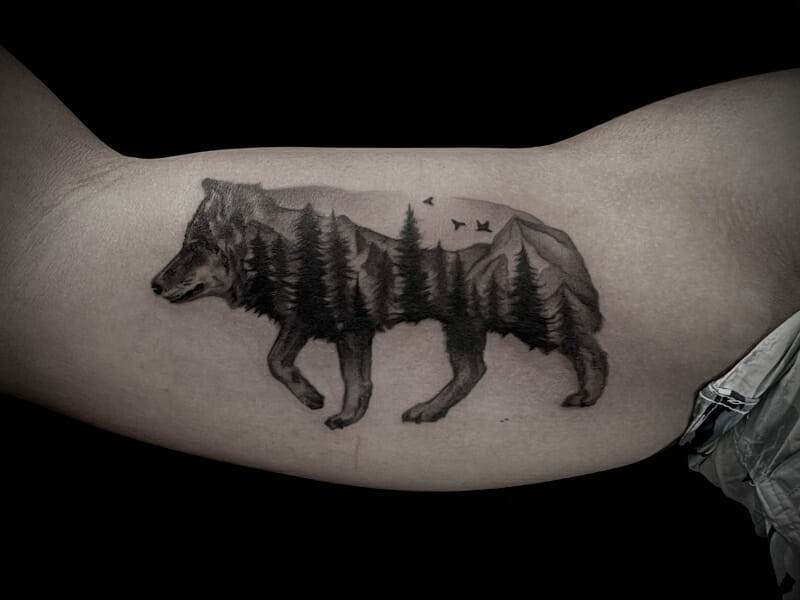Realism tattoos have become increasingly popular in the tattoo industry, captivating both tattoo enthusiasts and artists alike. These tattoos are known for their incredible attention to detail and lifelike representations of various subjects, ranging from portraits to animals to landscapes. The unique beauty and intricacy of realism tattoos have made them a sought-after choice for those looking to adorn their bodies with meaningful and visually stunning artwork.
Realism tattoos offer a level of detail and precision that is unmatched by other tattoo styles. Artists who specialize in realism tattoos are able to create stunningly accurate depictions that appear as if they have been transferred directly from a photograph onto the skin. This level of skill and artistry is what sets realism tattoos apart from other styles, making them a popular choice for those seeking a truly unique and visually striking tattoo.
The History of Realism Tattoos: From Traditional to Modern Styles
The art of realism tattoos has evolved over time, with artists continually pushing the boundaries of what is possible in terms of capturing lifelike images on the skin. The roots of realism tattoos can be traced back to traditional tattoo styles, where artists would use bold lines and vibrant colors to create simple yet impactful designs.
In the 20th century, artists such as Sailor Jerry and Ed Hardy began experimenting with more realistic techniques, incorporating shading and depth into their designs. These early pioneers laid the foundation for the modern realism tattoo movement, which gained momentum in the 1980s and 1990s.
Today, there are countless talented artists who specialize in realism tattoos, each bringing their own unique style and approach to the art form. Some notable artists in the field include Nikko Hurtado, Paul Acker, and Robert Hernandez, who have all made significant contributions to the realism tattoo movement.
Realism Tattoos vs. Traditional Tattoos: What’s the Difference?
While both realism tattoos and traditional tattoos are forms of body art, there are some key differences between the two styles. Traditional tattoos are characterized by bold lines, vibrant colors, and simple yet impactful designs. These tattoos often feature iconic imagery such as anchors, roses, and skulls, and are known for their timeless appeal.
On the other hand, realism tattoos aim to capture lifelike representations of various subjects, often resembling photographs or paintings. These tattoos require a high level of technical skill and attention to detail, as artists must carefully recreate every nuance and texture in order to achieve a realistic effect.
In terms of technique, traditional tattoos typically use bold lines and solid colors to create their designs, while realism tattoos rely on shading and color blending to achieve depth and dimension. Realism tattoos also tend to be larger in size due to the level of detail involved.
Ultimately, the choice between a realism tattoo and a traditional tattoo comes down to personal preference. Some may prefer the bold and timeless appeal of traditional tattoos, while others may be drawn to the intricate beauty and lifelike quality of realism tattoos.
The Anatomy of Realism Tattoos: Capturing Life in Detail
One of the defining characteristics of realism tattoos is their ability to capture lifelike details with incredible precision. Artists who specialize in realism tattoos must have a deep understanding of anatomy and how to recreate it on the skin.
To achieve a realistic effect, artists use a variety of techniques and tools. One common technique is called “black and gray,” where artists use different shades of black ink to create depth and dimension. This technique allows for a range of tones and textures, resulting in a highly realistic representation.
Another technique used in realism tattoos is called “color realism,” where artists use vibrant colors to recreate the natural hues and tones found in the subject. This technique requires a high level of skill and precision, as artists must carefully blend colors to achieve a seamless and realistic effect.
In terms of tools, artists often use a combination of tattoo machines and needles to create the desired effect. Fine needles are used for intricate details, while larger needles are used for shading and filling in larger areas.
The Role of Color in Realism Tattoos: Enhancing the Beauty of the Design

Color plays a crucial role in realism tattoos, enhancing the beauty and impact of the design. When used effectively, color can bring a tattoo to life, adding depth, dimension, and vibrancy.
In realism tattoos, color selection is key. Artists must carefully choose colors that accurately represent the subject they are trying to recreate. This requires an understanding of color theory and how different hues interact with each other.
Shading is another important aspect of color in realism tattoos. Artists use shading techniques to create depth and dimension, making the tattoo appear three-dimensional. This is achieved by using different shades of the same color or by blending multiple colors together.
When it comes to color realism tattoos, artists often use a combination of vibrant and muted colors to create a realistic effect. This allows for a range of tones and textures, making the tattoo appear more lifelike.
The Meaning Behind Realism Tattoos: Personalizing Your Ink
Realism tattoos offer a unique opportunity to personalize your ink and create a design that holds personal significance. Whether it’s a portrait of a loved one, a representation of a favorite animal, or a depiction of a meaningful place, realism tattoos allow individuals to express their personal stories and experiences through art.
The meaning behind a realism tattoo can vary greatly from person to person. Some may choose to get a realism tattoo as a way to honor a loved one who has passed away, while others may choose to get a tattoo that represents an important milestone or achievement in their life.
When choosing a design for your realism tattoo, it is important to take the time to reflect on what is meaningful to you. Consider the subjects, symbols, or images that hold personal significance and find an artist who can bring your vision to life.
The Pain Factor: What to Expect During a Realism Tattoo Session
Getting a tattoo, regardless of the style, involves some level of discomfort or pain. Realism tattoos are no exception. The pain experienced during a realism tattoo session can vary depending on factors such as the size and location of the tattoo, as well as an individual’s pain tolerance.
During a realism tattoo session, artists use tattoo machines to inject ink into the skin. This process can cause some discomfort, ranging from mild irritation to more intense sensations. However, many people find that the pain is manageable and worth it for the end result.
To manage pain during a realism tattoo session, there are several strategies you can try. One common approach is to take over-the-counter pain medication, such as ibuprofen or acetaminophen, before your appointment. This can help to reduce any discomfort or inflammation.
Additionally, some people find that using numbing creams or sprays can help to minimize pain during a tattoo session. These products work by temporarily numbing the skin, making the tattooing process more comfortable.
It is important to communicate with your artist throughout the tattoo session if you are experiencing any discomfort. They may be able to adjust their technique or take breaks to ensure your comfort.
Realism Tattoo Aftercare: Keeping Your Ink Vibrant and Healthy
Proper aftercare is essential for maintaining the vibrancy and health of your realism tattoo. After getting a tattoo, it is important to follow the instructions provided by your artist to ensure proper healing and minimize the risk of infection.
One of the most important aspects of aftercare is keeping the tattoo clean and moisturized. Your artist will likely recommend using a gentle, fragrance-free soap to clean the tattoo and applying a thin layer of ointment or moisturizer to keep the skin hydrated.
It is also important to avoid exposing your tattoo to direct sunlight or soaking it in water for extended periods of time during the healing process. Sunlight can cause fading and damage to the tattoo, while soaking can increase the risk of infection.
As your tattoo heals, it is normal for it to go through various stages, including peeling and itching. It is important to resist the urge to scratch or pick at the tattoo, as this can disrupt the healing process and potentially cause scarring.
By following proper aftercare instructions and taking care of your tattoo, you can ensure that it remains vibrant and healthy for years to come.
The Future of Realism Tattoos: Trends and Innovations in the Industry
The realism tattoo industry is constantly evolving, with new trends and innovations emerging all the time. As technology advances, artists are able to push the boundaries of what is possible in terms of capturing lifelike images on the skin.
One trend that has gained popularity in recent years is the use of hyperrealism techniques in tattoos. Hyperrealism takes realism to the next level, creating tattoos that are so detailed and lifelike that they appear almost three-dimensional. This trend has been made possible by advancements in tattooing equipment and techniques.
Another trend in the realism tattoo industry is the use of mixed media. Some artists are incorporating elements such as watercolor, oil painting, or even digital art into their realism tattoos, creating unique and visually stunning designs.
In terms of innovation, there have been advancements in tattoo ink formulations that allow for more vibrant and long-lasting colors. Additionally, new tattoo machines and needles have been developed that allow for more precise and detailed work.
As the realism tattoo industry continues to evolve, it is likely that we will see even more exciting trends and innovations in the future.

The Timeless Beauty of Realism Tattoos
Realism tattoos offer a unique and visually stunning form of self-expression. With their incredible attention to detail and lifelike representations, these tattoos have become increasingly popular in the tattoo industry.
The history of realism tattoos can be traced back to traditional styles, with artists continually pushing the boundaries of what is possible in terms of capturing lifelike images on the skin. Choosing the right artist for a realism tattoo is crucial, as their skill and experience can greatly impact the outcome of your tattoo.
Realism tattoos differ from traditional tattoos in terms of style, technique, and design. They require a high level of technical proficiency and attention to detail to achieve a realistic effect.
Color plays a crucial role in realism tattoos, enhancing the beauty and impact of the design. Artists carefully select colors that accurately represent the subject they are trying to recreate and use shading techniques to create depth and dimension.
Realism tattoos hold personal meaning and significance for many individuals, allowing them to express their personal stories and experiences through art. The pain factor associated with realism tattoos can vary depending on factors such as the size and location of the tattoo, but many find the pain manageable for the end result.
Proper aftercare is essential for maintaining the vibrancy and health of a realism tattoo. By following proper aftercare instructions and taking care of the tattoo, it can remain vibrant and healthy for years to come.
The future of realism tattoos is filled with exciting trends and innovations. As technology advances, artists are able to push the boundaries of what is possible in terms of capturing lifelike images on the skin.
In conclusion, realism tattoos offer a timeless beauty and significance that is unmatched by other tattoo styles. With their incredible attention to detail and lifelike representations, these tattoos have become a sought-after choice for those looking to adorn their bodies with meaningful and visually stunning artwork.



